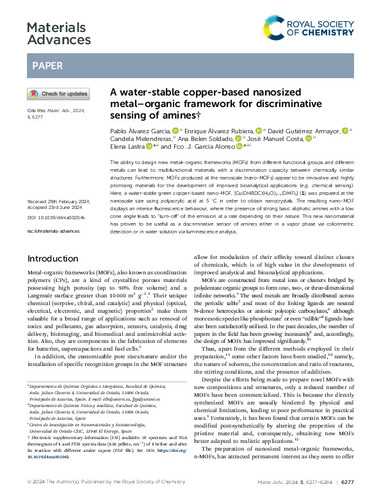A water-stable copper-based nanosized metal–organic framework for discriminative sensing of amines
Subject:
Copper nano-MOF, amines, fluorescence, sensor
Publication date:
Editorial:
Royal Society of Chemistry
Publisher version:
Citación:
Abstract:
The ability to design new metal–organic frameworks (MOFs) from different functional groups and different metals can lead to multifunctional materials with a discrimination capacity between chemically similar structures. Furthermore, MOFs produced at the nanoscale (nano-MOFs) appear to be innovative and highly promising materials for the development of improved bioanalytical applications (e.g. chemical sensing). Here, a water-stable green copper-based nano-MOF, [Cu(DHBDC)(H2O)2 x(DMF)x] (1), was prepared at the nanoscale size using polyacrylic acid at 5 1C in order to obtain nanocrystals. The resulting nano-MOF displays an intense fluorescence behaviour, where the presence of strong basic aliphatic amines with a low cone angle leads to ‘‘turn-off’’ of the emission at a rate depending on their nature. This new nanomaterial has proven to be useful as a discriminative sensor of amines either in a vapor phase via colorimetric detection or in water solution via luminescence analysis.
The ability to design new metal–organic frameworks (MOFs) from different functional groups and different metals can lead to multifunctional materials with a discrimination capacity between chemically similar structures. Furthermore, MOFs produced at the nanoscale (nano-MOFs) appear to be innovative and highly promising materials for the development of improved bioanalytical applications (e.g. chemical sensing). Here, a water-stable green copper-based nano-MOF, [Cu(DHBDC)(H2O)2 x(DMF)x] (1), was prepared at the nanoscale size using polyacrylic acid at 5 1C in order to obtain nanocrystals. The resulting nano-MOF displays an intense fluorescence behaviour, where the presence of strong basic aliphatic amines with a low cone angle leads to ‘‘turn-off’’ of the emission at a rate depending on their nature. This new nanomaterial has proven to be useful as a discriminative sensor of amines either in a vapor phase via colorimetric detection or in water solution via luminescence analysis.
DOI:
Local Notes:
OA ATUO24
Patrocinado por:
Financial support from the Principado de Asturias (Spain) through the project AYUD/2021/51323 and from the Ministry of Science and Innovation (Spain) through the projects Ref.PID2022-142323NB-I00, PID2020-115204RB-I00 and PID2020-117282RB-I00 is gratefully acknowledged. We acknowledge Larry R. Falvello from the Instituto de Nanociencia y Materiales de Aragón for their helpful discussions and for crystal determination of related compounds, Laura Roces for PXRD data acquisition, Borja Moreira for the ICP-MS analysis and Beatriz Ramajo for BET experiments and fruitful discussions. Candela Melendreras acknowledges her PhD grant (PAPI-22-TESIS-2) from the Plan Propio de la Universidad de Oviedo.
Collections
- Artículos [37549]
- Investigaciones y Documentos OpenAIRE [8420]
- Química Física y Analítica [639]
Files in this item





